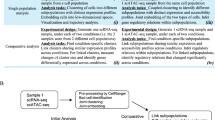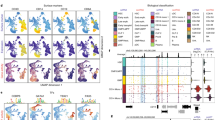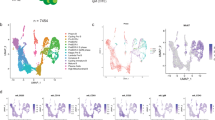Abstract
In recent years, we experienced an increasing development of new technologies that aim to comprehensively dissect the molecular genetics of cellular phenotypes. Pioneering studies have been performed on leukemia and lymphoma and then extended to many other types of malignancies. Genome-wide technologies allow taking snapshots of defined cellular context from an unbiased angle highlighting a complexity that we still struggle to fully interpret. The increasing availability of technologies to detect genetic, transcriptional and post-transcriptional characteristics of cellular systems needs to be associated with the development of computational tools to fully investigate these data in an integrated way. The evolution of different genome-wide technologies as well as data mining and integration tools will be discussed following studies performed on normal and malignant human mature B cells.
This is a preview of subscription content, access via your institution
Access options
Subscribe to this journal
Receive 12 print issues and online access
$259.00 per year
only $21.58 per issue
Buy this article
- Purchase on Springer Link
- Instant access to full article PDF
Prices may be subject to local taxes which are calculated during checkout



Similar content being viewed by others
References
Vogelstein B, Kinzler KW . The Genetic Basis of Cancer. McGraw-Hill Professional: New York, 2002; 1: 3–6.
Kuppers R . Mechanisms of B-cell lymphoma pathogenesis. Nat Rev Cancer 2005; 5: 251–262.
Kuppers R, Dalla-Favera R . Mechanisms of chromosomal translocations in B cell lymphomas. Oncogene 2001; 20: 5580–5594.
Klein U, Dalla-Favera R . Germinal centres: role in B-cell physiology and malignancy. Nat Rev Immunol 2008; 8: 22–33.
Pasqualucci L, Neumeister P, Goossens T, Nanjangud G, Chaganti RS, Kuppers R et al. Hypermutation of multiple proto-oncogenes in B-cell diffuse large-cell lymphomas. Nature 2001; 412: 341–346.
Pasqualucci L, Guglielmino R, Malek SN, Novak U, Compagno M, Nanjangud G et al. Aberrant somatic hypermutation targets an extensive set of genes in diffuse large B-cell lymphoma. Blood (ASH Annual Meeting Abstracts) 2004; 104: 1528.
Bartel DP . MicroRNAs: genomics, biogenesis, mechanism, and function. Cell 2004; 116: 281–297.
Golub TR, Slonim DK, Tamayo P, Huard C, Gaasenbeek M, Mesirov JP et al. Molecular classification of cancer: class discovery and class prediction by gene expression monitoring. Science 1999; 286: 531–537.
Klein U, Tu Y, Stolovitzky GA, Mattioli M, Cattoretti G, Husson H et al. Gene expression profiling of B cell chronic lymphocytic leukemia reveals a homogeneous phenotype related to memory B cells. J Exp Med 2001; 194: 1625–1638.
Rosenwald A, Alizadeh AA, Widhopf G, Simon R, Davis RE, Yu X et al. Relation of gene expression phenotype to immunoglobulin mutation genotype in B cell chronic lymphocytic leukemia. J Exp Med 2001; 194: 1639–1647.
Martinez N, Camacho FI, Algara P, Rodriguez A, Dopazo A, Ruiz-Ballesteros E et al. The molecular signature of mantle cell lymphoma reveals multiple signals favoring cell survival. Cancer Res 2003; 63: 8226–8232.
Basso K, Liso A, Tiacci E, Benedetti R, Pulsoni A, Foa R et al. Gene expression profiling of hairy cell leukemia reveals a phenotype related to memory B cells with altered expression of chemokine and adhesion receptors. J Exp Med 2004; 199: 59–68.
Alizadeh AA, Eisen MB, Davis RE, Ma C, Lossos IS, Rosenwald A et al. Distinct types of diffuse large B-cell lymphoma identified by gene expression profiling. Nature 2000; 403: 503–511.
Rosenwald A, Wright G, Leroy K, Yu X, Gaulard P, Gascoyne RD et al. Molecular diagnosis of primary mediastinal B cell lymphoma identifies a clinically favorable subgroup of diffuse large B cell lymphoma related to Hodgkin lymphoma. J Exp Med 2003; 198: 851–862.
Savage KJ, Monti S, Kutok JL, Cattoretti G, Neuberg D, De Leval L et al. The molecular signature of mediastinal large B-cell lymphoma differs from that of other diffuse large B-cell lymphomas and shares features with classical Hodgkin lymphoma. Blood 2003; 102: 3871–3879.
Wright G, Tan B, Rosenwald A, Hurt EH, Wiestner A, Staudt LM . A gene expression-based method to diagnose clinically distinct subgroups of diffuse large B cell lymphoma. Proc Natl Acad Sci USA 2003; 100: 9991–9996.
Shipp MA, Ross KN, Tamayo P, Weng AP, Kutok JL, Aguiar RC et al. Diffuse large B-cell lymphoma outcome prediction by gene-expression profiling and supervised machine learning. Nat Med 2002; 8: 68–74.
Monti S, Savage KJ, Kutok JL, Feuerhake F, Kurtin P, Mihm M et al. Molecular profiling of diffuse large B-cell lymphoma identifies robust subtypes including one characterized by host inflammatory response. Blood 2005; 105: 1851–1861.
Hans CP, Weisenburger DD, Greiner TC, Gascoyne RD, Delabie J, Ott G et al. Confirmation of the molecular classification of diffuse large B-cell lymphoma by immunohistochemistry using a tissue microarray. Blood 2004; 103: 275–282.
Berglund M, Thunberg U, Amini RM, Book M, Roos G, Erlanson M et al. Evaluation of immunophenotype in diffuse large B-cell lymphoma and its impact on prognosis. Mod Pathol 2005; 18: 1113–1120.
Robertson MJ, Kahl BS, Vose JM, de Vos S, Laughlin M, Flynn PJ et al. Phase II study of enzastaurin, a protein kinase C beta inhibitor, in patients with relapsed or refractory diffuse large B-cell lymphoma. J Clin Oncol 2007; 25: 1741–1746.
Basso K, Margolin AA, Stolovitzky G, Klein U, Dalla-Favera R, Califano A . Reverse engineering of regulatory networks in human B cells. Nat Genet 2005; 37: 382–390.
Friedman N, Linial M, Nachman I, Pe’er D . Using Bayesian networks to analyze expression data. J Comput Biol 2000; 7: 601–620.
Gardner TS, di Bernardo D, Lorenz D, Collins JJ . Inferring genetic networks and identifying compound mode of action via expression profiling. Science 2003; 301: 102–105.
Palomero T, Lim WK, Odom DT, Sulis ML, Real PJ, Margolin A et al. NOTCH1 directly regulates c-MYC and activates a feed-forward-loop transcriptional network promoting leukemic cell growth. Proc Natl Acad Sci USA 2006; 103: 18261–18266.
Margolin AA, Nemenman I, Basso K, Wiggins C, Stolovitzky G, Dalla Favera R et al. ARACNE: an algorithm for the reconstruction of gene regulatory networks in a mammalian cellular context. BMC Bioinformatics 2006; 7 (Suppl 1): S7.
Leitges M, Schmedt C, Guinamard R, Davoust J, Schaal S, Stabel S et al. Immunodeficiency in protein kinase cbeta-deficient mice. Science 1996; 273: 788–791.
Su TT, Guo B, Kawakami Y, Sommer K, Chae K, Humphries LA et al. PKC-beta controls I kappa B kinase lipid raft recruitment and activation in response to BCR signaling. Nat Immunol 2002; 3: 780–786.
Polo JM, Juszczynski P, Monti S, Cerchietti L, Ye K, Greally JM et al. Transcriptional signature with differential expression of BCL6 target genes accurately identifies BCL6-dependent diffuse large B cell lymphomas. Proc Natl Acad Sci USA 2007; 104: 3207–3212.
Mani KM, Lefebvre C, Wang K, Lim WK, Basso K, Dalla-Favera R et al. A systems biology approach to prediction of oncogenes and molecular perturbation targets in B-cell lymphomas. Mol Syst Biol 2008; 4: 169.
Krauthammer M, Kaufmann CA, Gilliam TC, Rzhetsky A . Molecular triangulation: bridging linkage and molecular-network information for identifying candidate genes in Alzheimer's disease. Proc Natl Acad Sci USA 2004; 101: 15148–15153.
Iossifov I, Zheng T, Baron M, Gilliam TC, Rzhetsky A . Genetic-linkage mapping of complex hereditary disorders to a whole-genome molecular-interaction network. Genome Res 2008; 18: 1150–1162.
Lenz G, Wright GW, Emre NC, Kohlhammer H, Dave SS, Davis RE et al. Molecular subtypes of diffuse large B-cell lymphoma arise by distinct genetic pathways. Proc Natl Acad Sci USA 2008; 105: 13520–13525.
Bea S, Zettl A, Wright G, Salaverria I, Jehn P, Moreno V et al. Diffuse large B-cell lymphoma subgroups have distinct genetic profiles that influence tumor biology and improve gene-expression-based survival prediction. Blood 2005; 106: 3183–3190.
Mullighan CG, Goorha S, Radtke I, Miller CB, Coustan-Smith E, Dalton JD et al. Genome-wide analysis of genetic alterations in acute lymphoblastic leukaemia. Nature 2007; 446: 758–764.
Pfeifer D, Pantic M, Skatulla I, Rawluk J, Kreutz C, Martens UM et al. Genome-wide analysis of DNA copy number changes and LOH in CLL using high-density SNP arrays. Blood 2007; 109: 1202–1210.
Acknowledgements
I am grateful to Ulf Klein, Pavel Sumazin and Roy L Maute for critical reading of the manuscript and to Govind Bhagat for providing photographic material used in Figure 2. I thank Riccardo Dalla-Favera and Andrea Califano for leading me into an interdisciplinary path where biological and computational sciences walk together.
Author information
Authors and Affiliations
Corresponding author
Rights and permissions
About this article
Cite this article
Basso, K. Toward a systems biology approach to investigate cellular networks in normal and malignant B cells. Leukemia 23, 1219–1225 (2009). https://doi.org/10.1038/leu.2009.4
Received:
Revised:
Accepted:
Published:
Issue Date:
DOI: https://doi.org/10.1038/leu.2009.4



